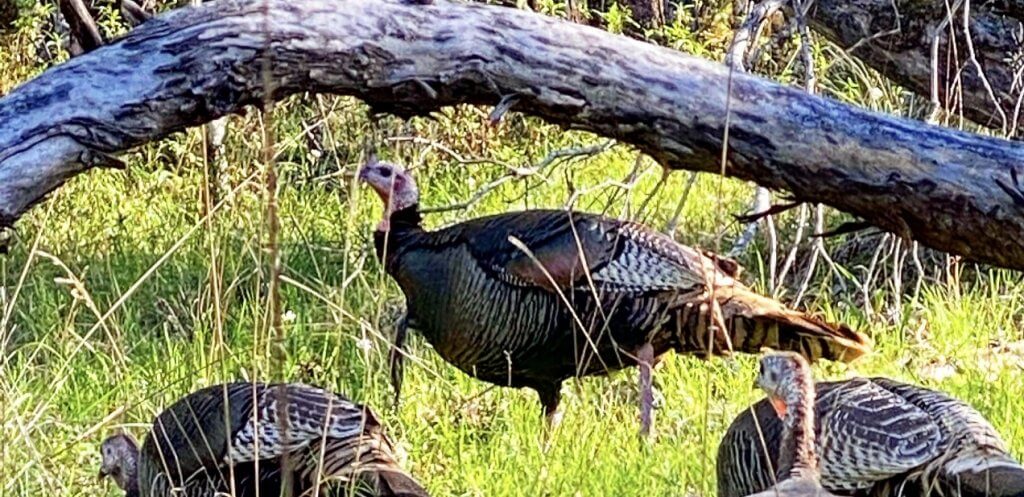
Talking turkey
5 fun facts about our wild gobblers
They’re gangly, they’re goofy, and they’re everywhere at China Camp. Wild turkeys have scratched and gobbled their way into our region in a very big way. The park’s abundant oak woodland habitat provides plenty of nutritious acorns and other foods, and the ground throughout the park teems with insects, larvae, little lizards, and other foodstuffs that turkeys love to, well, gobble down.
For more about wild turkeys, visit Cornell University’s All About Birds website.
Homeward bound
Are wild turkeys native?
Wild turkeys weren’t always here in Marin. In fact, hunting almost wiped out the birds in their native Eastern U.S. In 1988, California Fish & Game released a flock of wild turkeys as a potential game species for Marin County hunters. Records note the release site was private land–where hunting was allowed–adjacent to Loma Alta Open Space Preserve, where hunting was banned.
Not surprisingly, turkeys didn’t give a hoot about boundaries, and soon they were rambling into the protected public lands. The big birds found plenty to eat, and soon they were showing up on Mount Tamalpais and other parklands, including China Camp.
Baby talk
Why isn't a newly hatched turkey called a chick?
They’re technically called “poults.” Turkey poults are what’s known as “precocial” young, which means that they have open eyes, a fluff of feathers, and can run after their mother soon after they hatch. Good thing too, since Mom Turkey doesn’t feed them; the poults must fend for themselves from Day One.
FYI, unlike ready-to-run poults, “chicks” are baby birds which are born “altricial”: blind, featherless, nest-bound, helpless, and begging to be fed. Sound like any teenagers you know?
Net results
Are there too many turkeys in Marin?
Concerns have been raised that turkey populations can be causing problems in Marin, since the big birds can do quite a lot of damage when they scratch and scrape for food. Historic reports note that, in 2006 and 2007, MMWD used drop nets to capture turkeys and transplant them to state-designated hunting areas. But turkeys being turkeys, they rambled and roamed, making it tough, and pricey, to nab enough birds to curb their numbers, and the net-scapade was dropped.
A matter of taste
Does a wild turkey have the same flavor as a farm-raised Thanksgiving bird?
In-the-know folks say yes, and no. While your classic Butterball bird can be loaded with juicy breast, thigh, and leg meat, wild birds tend to be leaner and scrawnier from all that running around. As for taste, a wild turkey has the flavor you’d expect, with a gamey edge. A wild turkey’s diet of berries, nuts, seeds, insects, and pretty much whatever else it can scratch up on the ground gives the bird rich flavor.
What's in a name
Could turkeys be named after Turkey?
Tales abound on how turkeys got their name. One theory suggests the moniker was a holdover from ancient times, when merchants selling game birds followed shipping routes through Turkey on their way to European markets. Rumor has it the name was given to birds then. Only snag was there weren’t any wild turkeys in Europe to ship; the birds headed for market were more likely guinea fowl.
Another possibly more plausible theory hinges on the Ottoman Empire. In the 1500s, Spaniards plundered their way across Mexico. There, the conquistadors snapped up the already-domesticated (and delicious) common turkey, Meleagris gallopavo, and took it back to Spain.
A few decades later, during the reign of the Turkish Ottoman Empire, turkeys made their debut in English kitchens. At the time, it was “tres chic” to add the word “Turkey” and “Turkish” to names plants and foods new to English homes. For example, maize and pumpkins, even though they were New World plants that had nothing to do with Turkey or Ottomans or empires, were respectively known as “Turkish wheat” and “Turkish cucumbers.” As for our big bird that originally hailed from Mexico, it became know as a “Turkey-cock,” which was eventually shortened to turkey.
photo credits from top: Harriot Manley (images 1 & 2). Becky Matsumara/Flickr Creative Commons (image 3), Matt Wastler/Flickr Creative Commons (image 4), Jeffrey Balfus/flickr creative commons (image 5), Peter/flickr creative commons (image 6)
For more about wild turkeys, visit Cornell University’s All About Birds website.






